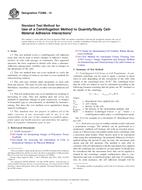Potřebujeme váš souhlas k využití jednotlivých dat, aby se vám mimo jiné mohly ukazovat informace týkající se vašich zájmů. Souhlas udělíte kliknutím na tlačítko „OK“.
ASTM F2529-13
Standard Guide for in vivo Evaluation of Osteoinductive Potential for Materials Containing Demineralized Bone (DBM)
Automaticky přeložený název:
Standardní Guide pro in vivo hodnocení osteoinduktivní potenciálu pro materiály obsahující demineralizované kosti (DBM)
NORMA vydána dne 1.2.2013
Informace o normě:
Označení normy: ASTM F2529-13
Poznámka: NEPLATNÁ
Datum vydání normy: 1.2.2013
Kód zboží: NS-54073
Počet stran: 16
Přibližná hmotnost: 48 g (0.11 liber)
Země: Americká technická norma
Kategorie: Technické normy ASTM
Kategorie - podobné normy:
Ostatní normy týkající se laboratorního lékařství
Biologie. Botanika. Zoologie
Anotace textu normy ASTM F2529-13 :
Keywords:
animal model, athymic, bioassay, demineralized bone, osteoconductive, osteoinductive, ICS Number Code 07.080 (Biology. Botany. Zoology),11.100.99 (Other standards related to laboratory medicine)
Doplňující informace
| Significance and Use | ||||||||||||||||||||||||||||||||||||||||||
|
4.1 This guide covers animal implantation methods and analysis of the explanted DBM-containing material to determine whether a material or substance possesses osteoinductive potential, as defined by its ability to cause bone to form 4.2 The test methods described here may be suitable for defining product specifications, cGMP lot release testing, research evaluation, regulatory submission, and so forth, but a positive outcome should not be presumed to indicate that the product will be osteoinductive in a human clinical application. At present, the only direct assays to assess new bone formation are in vivo, since the property of bone conduction or induction can only be assessed in a heterotopic or orthotopic site in a living animal. When these products are implanted in an orthotopic site, osteogenic factors already present at the implantation site may contribute to and enhance bone formation in conjunction with the osteoconductive nature of the product. Thus, orthotopic implantation of products may result in bone formation by acting on existing bone forming cells and not by causing mesenchymal stem cells to become osteochondroprogenitor cells. In contrast, when these products are implanted in a heterotopic site, no native osteogenic factors are present to contribute to or enhance bone formation. Thus, heterotopic implantation of products will only result in new bone formation by causing mesenchymal stem cells to become osteochondroprogenitor cells. In vitro assays have been described and some believe they may correlate to the results obtained from in vivo assays. However such 1.1 This guide covers general guidelines to evaluate the effectiveness of DBM-containing products intended to cause and/or promote bone formation when implanted or injected 1.2 The values stated in SI units are to be regarded as standard. No other units of measurement are included in this standard. 1.3 This standard does not purport to address all of the safety concerns, if any, associated with the use of DBM-containing bone-forming/promoting products. It is the responsibility of the user of this standard to establish appropriate safety and health practices involved in the development of said products in accordance with applicable regulatory guidance documents and in implementing this guide to evaluate the bone-forming/promoting capabilities of the product. |
||||||||||||||||||||||||||||||||||||||||||
| 2. Referenced Documents | ||||||||||||||||||||||||||||||||||||||||||
|
Podobné normy:
Historická
1.4.2012
Historická
1.3.2011
Historická
1.3.2014
Historická
1.5.2014
Historická
1.5.2014
Historická
1.1.2010
Doporučujeme:
Aktualizace technických norem
Chcete mít jistotu, že používáte pouze platné technické normy?
Nabízíme Vám řešení, které Vám zajistí měsíční přehled o aktuálnosti norem, které používáte.
Chcete vědět více informací? Podívejte se na tuto stránku.



 ASTM F2884-12
ASTM F2884-12 ASTM F2903-11
ASTM F2903-11 ASTM F2952-14
ASTM F2952-14 ASTM F3088-14
ASTM F3088-14 ASTM F3089-14
ASTM F3089-14 ASTM F997-10
ASTM F997-10
 Cookies
Cookies
